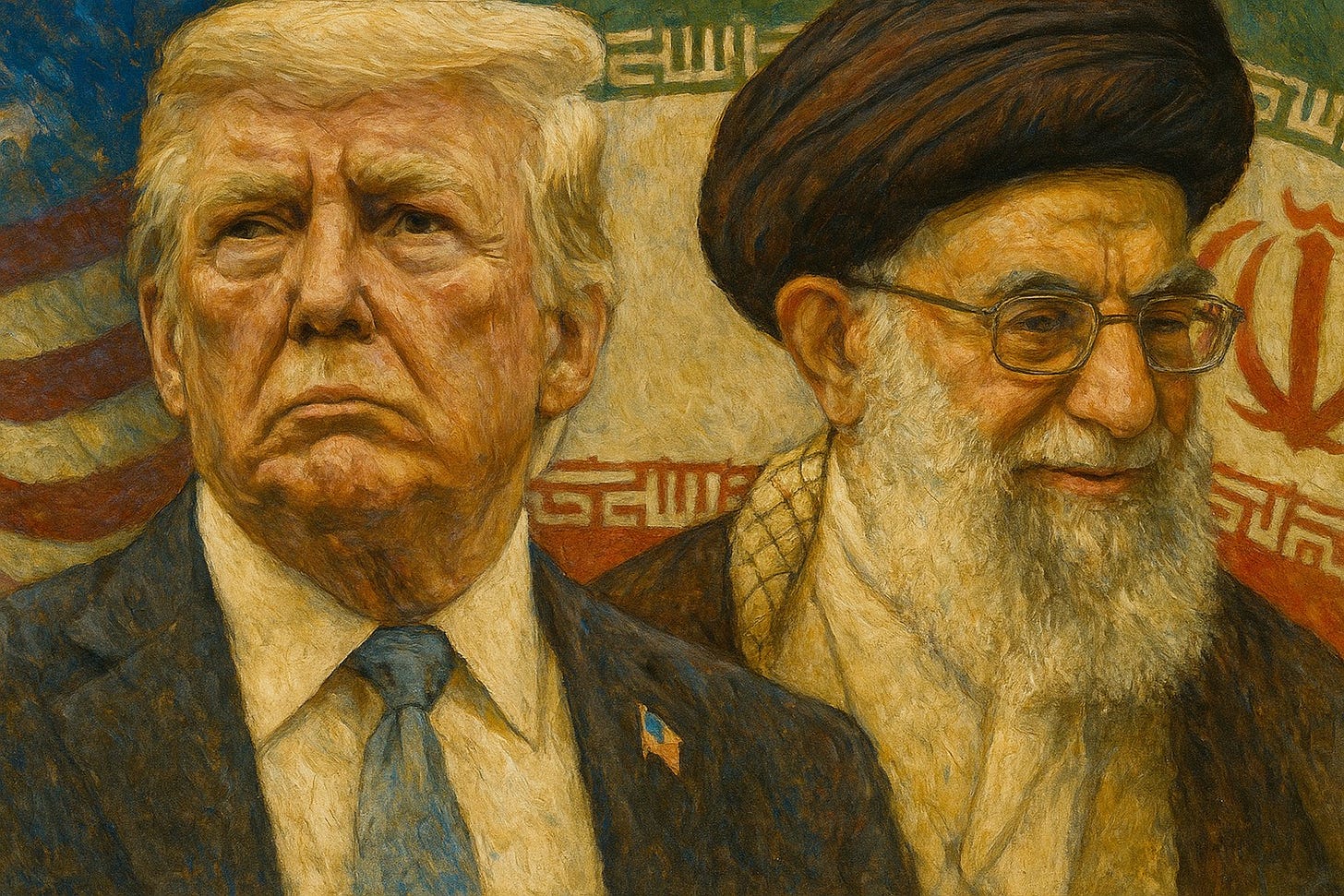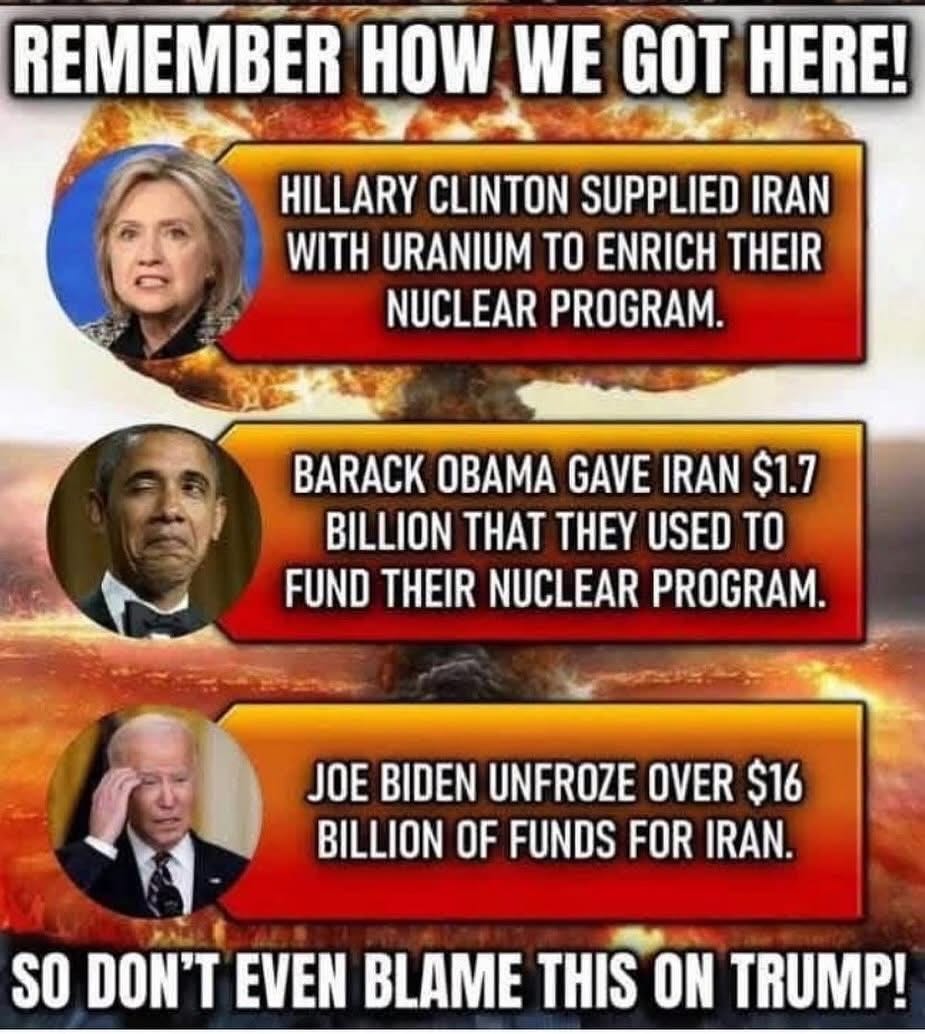Iran - Let’s Be Honest About How We Got Here
A Fact-Based Breakdown of the Iran Blame Game
On June 21, 2025, President Trump authorized airstrikes on three Iranian nuclear facilities, thrusting the United States into the heart of a dangerous regional escalation. The decision—announced without congressional approval or public intelligence briefings—immediately raised alarm among constitutional scholars, military analysts, and foreign policy experts alike.
In the hours following President Trump’s announcement of the bombing, a familiar pattern began to unfold across conservative media and pro-Trump corners of the internet. Instead of discussing the legal or strategic justification for the strikes—or the potential for regional escalation—the online narrative pivoted. Within minutes, the story wasn’t about Trump’s decision. It was about Hillary Clinton, Barack Obama, and Joe Biden.
Memes flooded social media, making bold and emotionally charged assertions:
Hillary Clinton gave Iran uranium.
Obama handed them $1.7 billion for nukes.
Biden unblocked $16 billion in funding for terrorism.
These claims, presented with patriotic conviction, were designed to rewrite the chain of causality—to suggest that if Trump was acting rashly, it was only because Democrats enabled Iran in the first place.
But none of these claims hold up. And if we’re going to understand how we got here, we need more than ideological memory. We need facts.
🔻Claim 1:
“Hillary Clinton supplied Iran with uranium to enrich their nuclear program.”
Status: ❌ False. There is no evidence—nor any mechanism—by which Hillary Clinton “gave uranium” to Iran.
This claim originates from the long-debunked Uranium One conspiracy theory, which ties back to a 2010 sale of a Canadian mining company (Uranium One) to a Russian firm (Rosatom). The company held rights to roughly 20% of U.S. uranium production capacity—not 20% of uranium itself, and certainly not weapons-grade material. The deal required approval from the Committee on Foreign Investment in the United States (CFIUS), which included nine federal agencies, one of which was the State Department.
There is no evidence that Clinton directly influenced the decision. More importantly, the uranium in question never left the United States. It was under the watch of the Nuclear Regulatory Commission the entire time.
Much of the public confusion stems from a $145 million donation to the Clinton Foundation, mostly attributed to Frank Giustra—a mining executive who had sold his shares in Uranium One before Clinton became Secretary of State. The optics are murky. The facts are not.
🟠Claim 2:
“Obama gave Iran $1.7 billion that they used to fund their nuclear program.”
Status: ⚠️ Misleading. This was a legal settlement of a decades-old dispute, paid in a manner dictated by U.S. sanctions policy—not a gift, and not aid.
The $1.7 billion in question was Iran’s money, paid to the U.S. in the 1970s for military equipment that was never delivered due to the Iranian Revolution. For decades, Iran pursued legal action in the Iran-U.S. Claims Tribunal at The Hague.
In 2016, the Obama administration chose to settle the case: $400 million in principal, plus $1.3 billion in interest. Because Iran remained under heavy financial sanctions, the funds were delivered in cash, using foreign currency and third-party banks. That fact—combined with a coordinated but separate release of American prisoners—created the appearance of a ransom payment.
The administration’s insistence that this was not quid pro quo may be technically accurate. But the optics were damning: a plane full of cash arriving within hours of a prisoner release. The public was never going to see that as anything but a deal. Still, there is no evidence the funds were used to advance Iran’s nuclear program. In fact, the nuclear deal signed that year (the JCPOA) significantly restricted Iran’s uranium enrichment—until Trump later withdrew from it.
🟡Claim 3:
“Joe Biden unfroze $16 billion of funds for Iran’s nuclear program.”
Status: 🚫 Highly misleading and factually thin.
This claim is based on Iranian assets frozen under international sanctions, some of which were made accessible for strictly humanitarian purposes—such as food and medicine—under Biden’s administration. The funds were held in foreign banks, not U.S. accounts, and were not taxpayer dollars. The $16 billion figure is an inflated estimate, often repeated without sourcing.
There is no indication that any of these assets were directed toward Iran’s nuclear program. Moreover, the release of these funds came with monitoring mechanisms and conditions, including third-party oversight through banks in Qatar.
Of the three claims circulating, this one may be the weakest—yet it’s also the most recent, and thus the most useful as a political deflection.
🧭 What These Claims Are Really Doing
This sudden wave of recycled allegations is not about Iran. It’s about shifting responsibility. The goal is to insulate Trump from scrutiny by arguing that he inherited an impossible situation—one made worse by the alleged generosity or naivete of his predecessors.
But none of the claims hold water, at least not in the way they’re being shared.
Yes, past administrations made choices. They struck deals, froze funds, enforced sanctions, lifted others. And yes, every one of those moves can be debated. But rewriting history to suggest that Clinton, Obama, or Biden actively enabled Iran’s nuclear ambitions with American help is a deliberate distortion of the record.
It’s also a distraction. Because the real questions—the ones we’re avoiding by rehashing old memes—are the ones we need to ask now:
Why did President Trump authorize military strikes on Iranian nuclear facilities without congressional approval?
Was this action justified by intelligence, or was it political theater?
What happens next—and who will bear the cost if things escalate?
Those are the questions this moment demands. And no amount of retroactive blame-shifting will answer them.
These narratives are designed to distract—to shift attention away from the present and toward selective interpretations of the past. But once we dispense with the myths, we’re left with the real question:
Why did President Trump order these strikes in the first place—and what evidence did he offer, if any?
The rationale offered was familiar: a looming threat. According to the administration, the strikes were a necessary part of a joint campaign with Israel to stop Iran from acquiring nuclear weapons. But what was missing was equally familiar: evidence.
Despite dramatic rhetoric about an imminent nuclear breakout, no specific intelligence was made public to support the claim that Iran was on the verge of weaponization. In fact, U.S. intelligence agencies had repeatedly assessed that Iran remained several years away from developing a viable nuclear weapon—an assessment that had not changed in the weeks prior to the strikes.
“This is not just reckless; it’s a direct violation of the Constitution’s war powers,” said one Democratic senator, echoing a chorus of bipartisan concern.
🚨 A President Alone
The decision came without consultation or authorization from Congress, marking yet another instance of executive overreach in military affairs. No declaration of war. No War Powers Resolution notification in advance. Just a sudden assertion of presidential authority to carry out targeted military action against a sovereign state—without formal oversight.
This unilateral approach stood in stark contrast to Trump’s previous campaign claims. He had promised to end “forever wars” and keep America out of new conflicts. Instead, this strike expanded U.S. military involvement in one of the most volatile regions on the planet—without a clear objective, exit strategy, or accountability framework.
🧨 Escalation by Design?
Some observers suggest this was more than just a military miscalculation. It was a political maneuver. With domestic investigations mounting, economic turbulence threatening reelection narratives, and foreign policy credentials in need of a boost, a high-stakes international strike may have served as a distraction, not a solution.
Even conservative voices expressed caution:
“We need to be very clear about what we’re doing here,” said one former Trump official anonymously. “The risk of blowback is enormous.”
Critics argue that without a formal declaration of war, coordinated diplomacy, or broad international support, this operation undermined U.S. credibility and raised the risk of further destabilization—not just in Iran, but across the region.
⚖️ What Comes Next?
Already, protests have erupted across global capitals. Iran has vowed retaliation. And members of Congress—many of whom were caught off guard—are calling for emergency hearings.
The legal questions are mounting:
Did Trump violate the War Powers Resolution?
Was the intelligence sufficient to justify a self-defense rationale?
Will this spark retaliatory action against U.S. assets or allies?
What’s clear is this: the decision to strike was made in the absence of debate, evidence, and democratic process. And the consequences may extend far beyond the bomb craters in Fordow.




